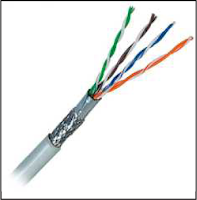The different devices containing
a building automation network are either joined by cables or talk wirelessly to
one another, or perhaps a combination of both. In Networking 101, we are going
to focus on network devices joined by cables. Here are different sorts of networking cable
typically encountered in building automation networks.
 |
| Networking cable |
Networking Cables
Two wires are bended around each
other at a uniform number of twists per inch to shape the twisted pair. The
most widely recognized sort of networking cable utilized in building automation
networks is the "twisted pair" cable.
Not all twisted pair cables are
made equivalent. There are electrical qualities, for example, resistance and
capacitance per foot that change between distinctive brands and models of
twisted pair cable. Basically the lower the capacitance and resistance of
twisted pair cable, the better it performs in networks. It's a good thought to choose a
networking or LAN cable that
is particularly suggested by the manufacturer for use in your sort of network.
On the off chance that network-particular cable is not accessible,
substitutions can be made.
On the off chance that the capacitance and
resistance per foot of the proposed substitute cable is as low as or lower than
the suggested cable, the substitute cable ought to be acceptable. A few styles
of networking cable are accessible with or without a metallic shield around the
outside of the wires. Shielded cable
basically offers with decreasing some assistance with noising pickup, yet the
cable will cost more.
RS-485
 |
| LAN cable |
RS-485 is utilized broadly in
building automation networks. RS-485 uses a one twisted-pair to send the
information. It additionally utilizes a third "reference wire" additionally
the twisted pair. There is verbal confrontation among clients as to whether the
reference wire is always required, and a few devices do not include a terminal to
connect a reference wire. In any case, to be secure it's generally best to
incorporate it in the cable. RS-485 devices normally utilize screw terminals to
connect with the cable.
FT-10 “Free Topology” (Lon works)
Like RS-485, FT-10 utilizes a one
twisted pair to convey the information, yet FT-10 does not utilize a third
"reference wire". Like RS-485 devices, Lon works FT-10 devices also typically
utilize screw terminals to connect with the network cable.
On the off chance that you need
to convey between a RS-485 network and a FT-10 network, you must utilize a
"Gateway" gadget which has a RS-485 port on one side and a FT-10 port
on the other side.
Ethernet
There are various different
versions of "Ethernet" networks. The two styles of Ethernet cables
you're liable to experience in building automation are assigned as Cat
5 (Category 5) and Cat 5e (Category 5 Enhanced). Both cable styles
can be utilized with either 10BASE-T or 100BASE-T, however Cat 5e cable gives best
execution.
RS-232
RS-232 is a physical communications
layer that is utilized for making point-to-point connections between 2 bits of
gear. This RS-232 port is not for the network connection, just to configure the
gadget prior to utilizing it on a network.
No comments:
Post a Comment